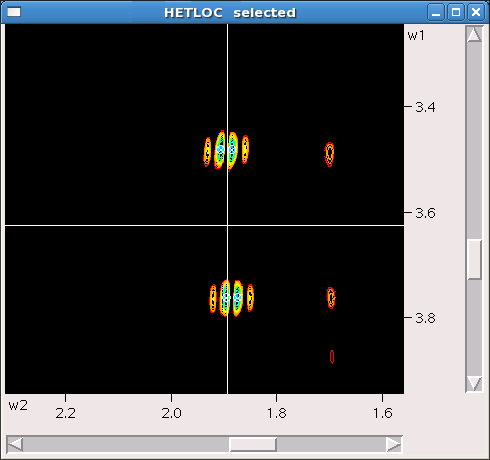Analysis of HETLOC data
From NMR Wiki
HETLOC [1, 2] experiment can be used to obtain one, two, three and more -bond separated heteronuclear J couplings as well as their relative signs, which depend on the conformation and stereochemical arrangement of atoms in the molecule.
HETLOC experiment has a limitation that it won't show couplings to carbon atoms (or other X-nuclei to which HETLOC experiment might be tuned) not connected to a proton. That is because intrinsically HETLOC is a TOCSY experiment.
Before starting to analyze spectrum, list the couplings to be collected (chances are all observable couplings won't be needed).
Then, open HETLOC spectrum, and for a given coupling between atoms Cx and Hy:
- draw a horizontal line at ω1 (usually vertical dimension) = δ(Hx) - i.e. chemical shift of Cx-attached proton.
- draw a vertical line at ω2 = δ(Hy)
- alternatively move a cursor so that cross-hairs correspond to those lines
- note the point of intersection of the two lines
- somewhere symmetric to that point along the vertical line there might be two peaks or groups of peaks (i.e. if they are observable)
- if the peaks appear to be missing - try redrawing spectrum at lower first contour level (~intensity scale in 2D plane)
- two (groups of) peaks will be offset in ω1 by 1JCxHx and in ω2 -by the sought value of nJCxHy
- take a careful note about sign of coupling - is the doublet tilted to the left or to the right (i.e. same as main dagonal?)
Related documents
Sensitivity- and Gradient- enhanced HETLOC
Dipsi2etgpjcsix1, Sensitivity and Gradient- enhanced HETLOC
References
- KURZ, M and SCHMIEDER, P and KESSLER, H. HETLOC, AN EFFICIENT METHOD FOR DETERMING HETERONUCLEAR LONG-RANGE COUPLINGS WITH HETERONUCLEI IN NATURAL ABUNDANCE. Angewandte Chemie International edition in English 30(10):1329--1331, 1991. BibTeX
-
Uhr{\i}´n, D and Batta, G and Hruby, VJ and Barlow, PN and K{\"o}v{\'e}r, KE. Sensitivity-and Gradient-Enhanced Hetero ($\omega$1) Half-Filtered TOCSY Experiment for Measuring Long-Range Heteronuclear Coupling Constants. Journal of Magnetic Resonance 130(2):155--161, 1998. BibTeX


